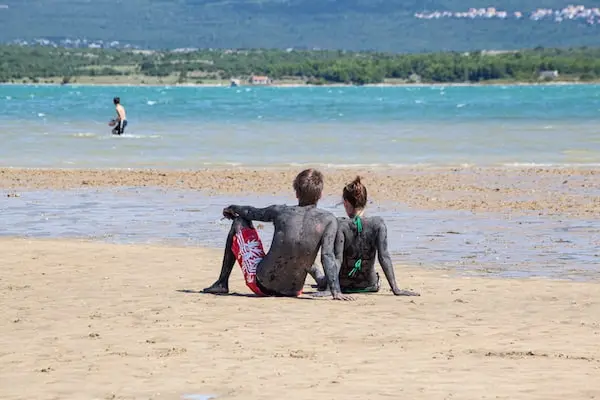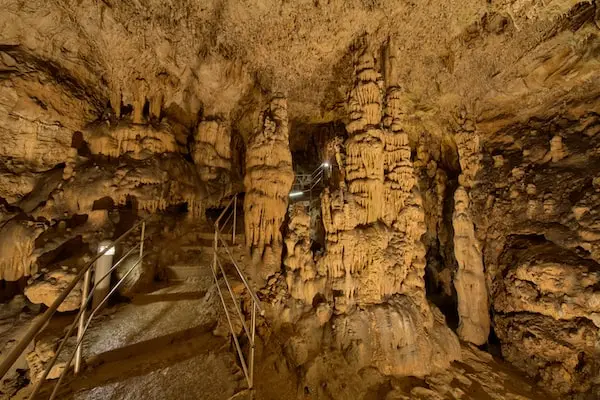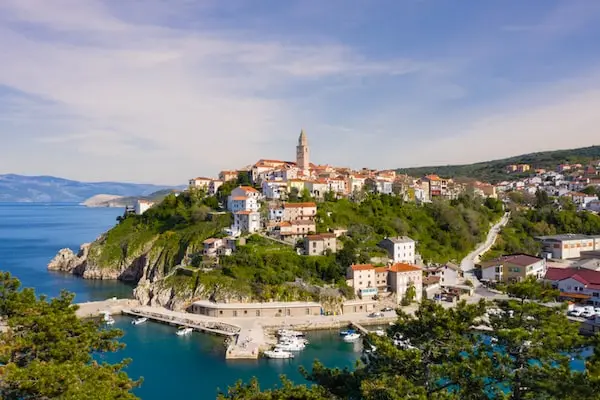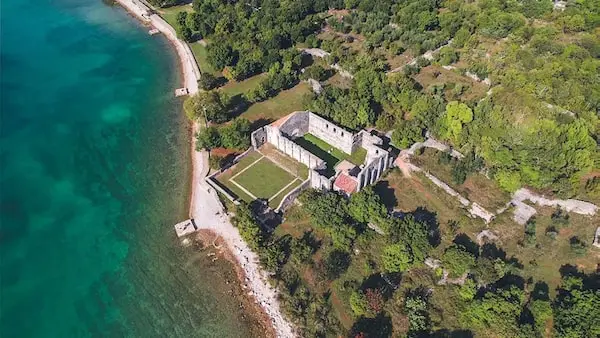What to see in Krk island
Table of Contents
The island of Krk, nestled in the top north Adriatic Sea, is one of Croatia’s most enchanting destinations. It’s a place where ancient history, stunning natural beauty, and vibrant local culture converge, offering something for every type of traveler. We prepared a comprehensive guide of the best Krk island attractions. To suit different interests, we divided them in three categories: natural attractions, historical attractions and old city centres. Keep reading and find out the answers to every tourist dilemma: what to see in Krk island.
Here’s our guide to the must-see sights and best Krk island attractions:
Best natural Krk island attractions
1. Vela plaža beach in Baška
Vela Plaža Beach in Baška is one of the most famous and beloved beaches on the island of Krk, and indeed in all of Croatia. Stretching over 1.8 kilometers, this stunning pebble beach is renowned for its crystal-clear turquoise waters and breathtaking views of the surrounding mountains and the Adriatic Sea. The beach’s gentle slope into the sea makes it a perfect destination for families with children. It offers a safe and enjoyable environment for swimmers of all levels.
Vela Plaža is well-equipped with various amenities. This includes sun loungers and umbrellas for rent, showers, changing rooms, and lifeguards on duty to ensure everyone’s safety. Along the beachfront, visitors will find a vibrant promenade. It’s filled with cafes, restaurants, and shops, providing plenty of options for refreshments and relaxation after a day in the sun.
For those seeking activities beyond sunbathing and swimming, Vela Plaža offers a range of water sports. You have the option of paddle boarding, kayaking, and windsurfing. The beach’s lively atmosphere and stunning natural beauty make it a must-visit destination for anyone traveling to the island of Krk, promising an unforgettable day by the sea.

2. Oprna beach in Stara Baška
Oprna Beach, located near the quaint village of Stara Baška on the island of Krk, is a hidden gem. It offers a slice of paradise for those willing to seek it out. Unlike the more accessible beaches on the island, Oprna Beach is a secluded cove. It can be reached by a somewhat steep path or by boat, adding to its untouched and serene atmosphere.
This stunning beach boasts fine pebbles set against the backdrop of dramatic cliffs and crystal-clear azure waters. It is an ideal spot for swimming, snorkeling, and sunbathing in a peaceful setting. The natural beauty of the surroundings, with the Mediterranean vegetation and the mesmerizing play of light on the water, creates a perfect ambiance for relaxation and contemplation.

Oprna Beach is relatively undeveloped. Thanks to that it retains its natural charm but also lacks the facilities found on more commercial beaches. Visitors are advised to bring their own supplies, such as water, snacks, and sun protection. The absence of crowds and commercialization makes Oprna Beach a favorite among those looking to escape the hustle and bustle and immerse themselves in the tranquil beauty of Croatia’s Adriatic coast.
3. Sandy beach Meline with the healing mud
Sandy Beach Meline, located in the Soline Bay, is truly one of a kind. It offers visitors not just a day at the beach but a natural wellness experience. This beach is renowned for its rare sandy shoreline in a region predominantly known for pebble beaches. It provides a soft, comfortable base for sunbathers and a safe, gentle entry into the sea for swimmers of all ages, particularly children.
What sets Meline apart from other beaches is its famous healing mud, believed to have therapeutic properties. This natural remedy, found at the edge of the water, has been used for centuries to treat various skin diseases and rheumatic conditions. Visitors to Meline often partake in the tradition of covering themselves in mud, basking in the sun as it dries, and then washing off in the sea, hoping to reap the health benefits attributed to the mud’s minerals.

The beach is equipped with basic amenities such as showers and changing rooms. There are cafes and restaurants nearby where visitors can grab a bite or a refreshing drink. The combination of the sandy beach, shallow warm waters, and therapeutic mud makes Meline a unique destination. It’s ideal for those looking to enjoy a relaxing day at the beach while also taking advantage of the natural healing properties the area has to offer.
4. Biserujka stalactite cave near Rudine
The Biserujka Cave, near the village of Rudine, is a fascinating natural wonder that beckons explorers and nature enthusiasts alike. It is known for its impressive array of stalactites, stalagmites, and other calcite formations. The cave offers a glimpse into the underground world’s beauty and mystery.
Discovered over a century ago, Biserujka has since been developed to accommodate visitors. It has pathways and lighting installed to highlight the cave’s stunning features and ensure a safe exploration experience. Despite its relatively modest size, the cave is rich in speleothems, the intricate shapes formed by millennia of mineral deposits. The constant cool temperature and the play of light on the formations create an otherworldly atmosphere that captivates all who enter.

Legend has it that Biserujka (biser = pearl) was named after the treasures supposedly hidden by pirates within its depths. This folk story adds a layer of intrigue to the visit. Whether drawn by the allure of adventure, the desire to learn about geology, or simply the wish to witness the Earth’s natural artistry, visitors to Biserujka Cave are sure to be enchanted by its subterranean beauty. The cave is not only a testament to nature’s creativity but also an educational site where guides share insights into the geological processes that shaped this remarkable landscape.
5. Baška Glagolitic Trail
The Baška Glagolitic Trail is an exceptional cultural and educational path that pays homage to the Glagolitic alphabet. It is the oldest known Slavic script, deeply intertwined with Croatian heritage. This unique trail winds through the picturesque landscapes around Baška. The town renowned for its historical and linguistic significance, most notably as the site where the Baška Tablet was found. You can read more about the Baška Tablet below.
The trail features a series of sculptural installations that represent various letters of the Glagolitic alphabet. Each sculpture is strategically placed at locations of historical and natural beauty. They invite visitors to explore the rich cultural tapestry and stunning scenery of the area. The trail not only educates participants about the Glagolitic script and its historical context but also encourages a deeper appreciation for the region’s heritage and landscapes.

Walking the Baška Glagolitic Trail is an immersive experience that bridges the gap between past and present. This allows visitors to step back in time and connect with the ancient Slavic culture while enjoying the tranquil beauty of Krk Island. It’s an ideal activity for history buffs, language enthusiasts, and nature lovers alike. It offers a unique journey through Croatia’s cultural and natural wonders.
The old towns on the island of Krk
1. The historic old city center of Krk
The historic old town of Krk is a captivating blend of ancient history and Mediterranean charm. It’s situated on the northern coast of the island that shares its name. Enclosed by well-preserved defensive walls, the old town is a treasure trove of cultural and architectural heritage. It offers a journey back in time through its narrow, cobblestone streets.
At the heart of Krk’s old town lies the Cathedral of the Assumption. It’s a magnificent testament to various architectural styles that have influenced the region over centuries, including Romanesque, Gothic, and Baroque. Nearby, the Frankopan Castle stands as a symbol of the town’s medieval might. It is characterised by its imposing towers and fortifications that have safeguarded the community through tumultuous periods in history.
Wandering through the old town, visitors can admire the harmonious blend of historical periods reflected in its buildings and public spaces. The town squares, adorned with ancient Roman inscriptions and medieval sculptures, are vibrant gathering spots where past and present converge. The narrow lanes lead to hidden courtyards, small churches, and charming boutiques. They offer local crafts and delicacies, inviting exploration and discovery at every turn.
Krk’s old town is not just a historical monument. It’s a living, breathing community where traditional festivals, markets, and daily life unfold amidst the backdrop of centuries-old architecture. This harmonious blend of history, culture, and everyday life makes the old town of Krk a must-visit destination for anyone seeking to immerse themselves in the authentic spirit of the Croatian Adriatic.

2. The historic old town of Vrbnik
The historic old town of Vrbnik is perched dramatically on a cliff overlooking the Adriatic Sea. It is one of the most picturesque and enchanting places on the island of Krk. It’s known for its narrow streets, one of which, Klančić, claims to be the narrowest in the world. Vrbnik invites visitors to lose themselves in its labyrinth of alleys and stone houses, which seem to whisper tales of the past.
Dating back to medieval times, Vrbnik’s charm is not only in its stunning location but also in its rich cultural heritage. The town is renowned for its tradition in winemaking, particularly the indigenous Žlahtina white wine, which is cultivated in the vineyards surrounding the area. Wine enthusiasts can visit local wineries for tastings and learn about the production process of this unique varietal.

Among the historical treasures of Vrbnik is the Parish Church of St. John the Baptist. It features a blend of Gothic and Renaissance elements, and the valuable collection of old Glagolitic manuscripts housed in the Vrbnik Town Library. These manuscripts highlight Vrbnik’s significance in the preservation of Croatian culture and language.
Exploring Vrbnik offers a captivating journey through time, from its ancient buildings and cultural landmarks to its breathtaking views of the sea. The town’s atmosphere is serene and inviting. This makes it a perfect destination for those looking to experience the beauty and history of the Croatian coast.
3. The historic old town of Baška
The old town of Baška is a captivating blend of cultural heritage and natural beauty, situated on the southern coast of Krk. Famous for its stunning beach Vela Plaža, Baška also boasts a rich history that draws visitors into a bygone era. The old town is characterized by its narrow, winding streets and traditional stone houses. It offers a glimpse into the Mediterranean lifestyle of centuries past.
At the heart of Baška’s historical narrative is the Baška Tablet. This 11th-century stone inscription was found in the nearby Church of St. Lucy in Jurandvor. This significant artifact is one of the oldest records of the Glagolitic script. It highlights Baška’s importance in the development of Croatian literacy and national identity. The script, unique to the region, underscores the area’s rich cultural and linguistic heritage.
Aside from its historical significance, Baška’s old town invites exploration and discovery. Visitors can wander through its alleys, soaking in the atmosphere of this ancient settlement. You can climb the surrounding hills for breathtaking views of the town and the Adriatic Sea. The blend of historical richness and scenic beauty makes Baška a must-visit destination for those seeking to uncover the treasures of the Croatian coast.

4. The historic old town of Omišalj
Omišalj is perched on a high cliff overlooking the northern tip of the island of Krk. It is one of the oldest and most picturesque towns in the region. This historic old town is a treasure trove of medieval architecture. It’s characterized by narrow cobblestone streets, ancient churches, and charming stone houses that tell tales of centuries past. Its strategic position offers breathtaking views of the Kvarner Bay, making it a captivating spot for both history enthusiasts and lovers of natural beauty.
The town’s rich history is evident in its well-preserved town walls. The Romanesque Church of the Assumption from the 12th century stands as a testament to Omišalj’s medieval heritage. The streets of Omišalj radiate a timeless ambiance. They inviting visitors to explore its hidden nooks, historical buildings, and tranquil squares where the past and present merge seamlessly.

Apart from its architectural and historical sites, Omišalj is renowned for its vibrant cultural scene. It hosts various festivals and events throughout the year that celebrate its heritage and community spirit. The town also offers a gateway to pristine beaches and coves, providing a perfect blend of cultural exploration and leisure.
Visiting Omišalj offers a unique glimpse into the ancient life of the Adriatic. Here each stone and corner has a story to tell, making it an essential stop for anyone traveling to the island of Krk.
5. The historic old town of Dobrinj
Nestled in the heart of the island, the historic old town of Dobrinj stands as a testament to the rich cultural and historical tapestry of the region. Perched atop a hill, it offers panoramic views of the surrounding countryside, characterized by olive groves, vineyards, and the deep blue of the Adriatic Sea. This serene setting encapsulates the essence of Mediterranean charm and tranquility.
Dobrinj’s origins date back to medieval times, and its architecture reflects the various periods through which it has endured. The town’s narrow, winding streets and traditional stone houses invite visitors to step back in time and explore its hidden corners. Central to Dobrinj’s allure is the Church of Saint Stephen. It’s a stunning example of Romanesque architecture that houses valuable artistic and historical treasures.

Not merely a place of breathtaking beauty, Dobrinj is also a cultural hub. It is home to the Infeld Gallery, which showcases contemporary art. The Ethnographic Museum allows visitors to immerse themselves in the customs, traditions, and everyday life of the island’s past inhabitants. The town frequently hosts cultural events and exhibitions, bringing together locals and tourists in celebration of its heritage.
Exploring Dobrinj offers a unique opportunity to experience the tranquility and beauty of Krk’s inland areas, away from the bustling coastal towns. It is a place where history, culture, and natural beauty intertwine, providing a peaceful retreat for those seeking to connect with the island’s soul.
Most popular historical Krk island attractions
1. Baška Tablet and St Lucy’s Church in Jurandvor
The Baška Tablet, discovered in the small village of Jurandvor near Baška, is one of Croatia’s most important national treasures. This significant archaeological find, dating back to around 1100 AD, is a large stone slab inscribed with Glagolitic script. It’s the oldest known Slavic alphabet. The inscription on the Tablet commemorates King Zvonimir and is a pivotal document in the study of Croatian history and language, marking the first mention of Croatia in a native document.

St. Lucy’s Church in Jurandvor, the site where the Baška Tablet was found, serves as a modest yet profound backdrop to this monumental piece of Croatian heritage. The church itself is a beautiful example of Romanesque architecture, offering a glimpse into the medieval period of the region. Despite its small size, the church holds a significant place in the hearts of the Croatian people due to its association with the Baška Tablet.
Today, visitors can explore a replica of the Baška Tablet within St. Lucy’s Church. The original is preserved in the Croatian Academy of Sciences and Arts in Zagreb for protection. The church and the Tablet together offer an immersive experience into the cultural and historical depth of Krk island. They provide a tangible connection to the past and a reminder of Croatia’s rich linguistic and historical legacy.
2. Monastery on the island of Košljun
Košljun is a small islet in the picturesque bay of Punat. The Monastery on Košljun is a serene and spiritually significant site. This Franciscan monastery is not just a place of worship but also a treasure trove of culture and history, nestled amidst lush Mediterranean vegetation. It dates back to the 15th century. Although the island itself has been a site of religious significance since the ancient times, when it was first inhabited by Benedictine monks.
Today, the Monastery of Košljun is home to a small community of Franciscan monks who maintain the site and its extensive museum. The museum houses an impressive collection of ethnographic items, religious art, a library containing ancient manuscripts, and various other artefacts that tell the rich history of the island and the surrounding region. Among its most valuable possessions are rare editions of religious texts and works of sacred art that date back several centuries.

Visitors to Košljun can explore the monastery and its museum and take a walk through the tranquil forest that covers the island. Here you can enjoy the peaceful atmosphere that seems a world away from the hustle and bustle of modern life. The islet is easily accessible by a short boat ride from Punat, making it a popular day trip for those staying on Krk. The Monastery on the island of Košljun offers a unique blend of spiritual, cultural, and natural beauty. It provides a reflective and enriching experience for all who visit.
3. Fulfinum Mirine
The Fulfinum Mirine is an archaeological site located near the town of Omišalj. It offers a fascinating glimpse into the ancient past of the region. This historical treasure dates back to the 1st century AD. It was established as Fulfinum, a Roman settlement built by veterans of the Roman army. The site later evolved, giving rise to the early Christian complex known as Mirine.
One of the most captivating aspects of Fulfinum Mirine is the remains of an early Christian basilica from the 5th century. These remains showcase the architectural and religious transitions of the time. The site is a testament to the rich tapestry of historical layers that have contributed to the island’s identity, from its Roman roots to its Christian development.

Exploring Fulfinum Mirine provides a unique opportunity to walk through ruins that echo the daily lives of their ancient inhabitants. The archaeological remains paint a vivid picture of a bustling community, complete with residential areas, a forum, and a necropolis. It’s a place where history enthusiasts can immerse themselves in the world of the ancients, imagining the grandeur of the past amidst the serene beauty of the Adriatic landscape.
The Fulfinum Mirine site is not just an attraction for those interested in archaeology and history. It’s a cultural landmark that connects visitors to the deep and diverse heritage of Krk Island. It offers insights into the complex tapestry of human civilization in this part of Croatia.
Conclusion
Krk is a destination that combines the allure of the ancient world with natural beauty and modern leisure facilities. Whether you’re interested in history, nature, or just enjoying in the sun on beautiful beaches, Krk has something for everyone.
We hope we helped you decide what to see in Krk island. You are always welcome to contact us for more information about the most popular Krk island attractions. And if you need a place to stay, check out our selection of accommodation on the island of Krk.